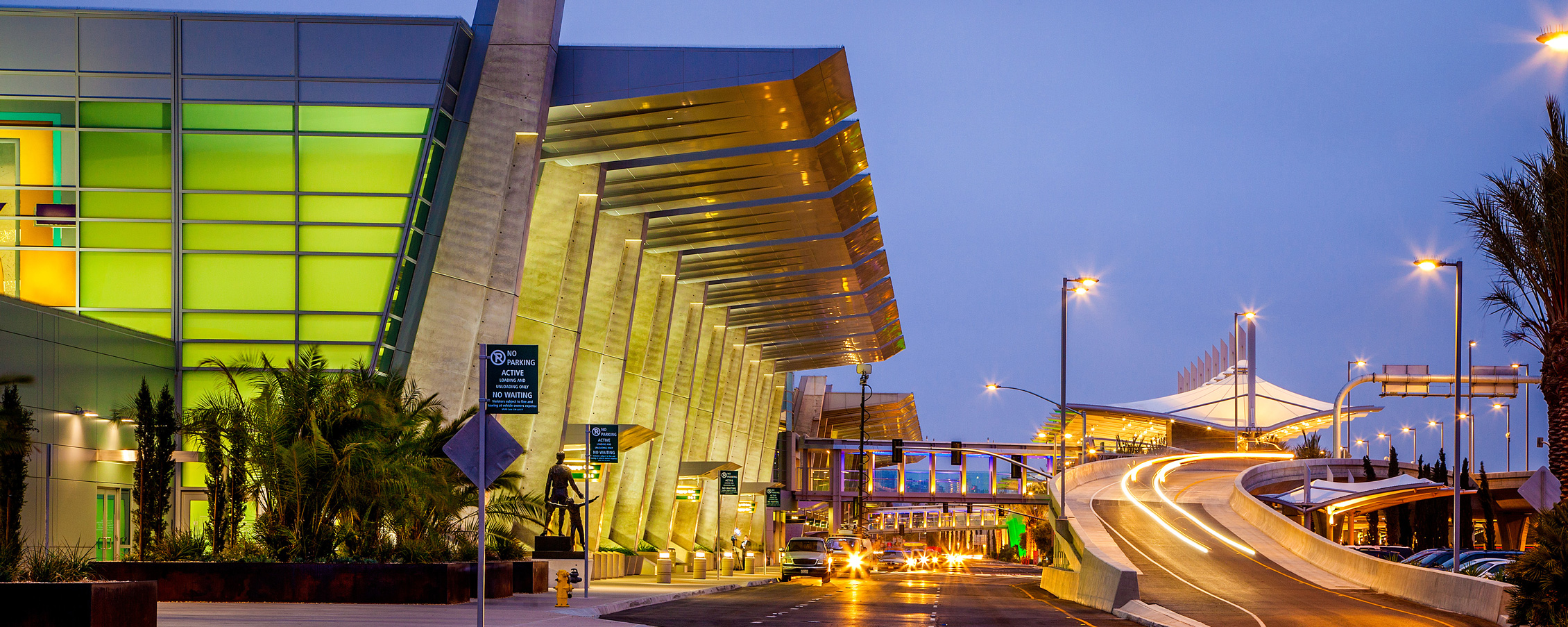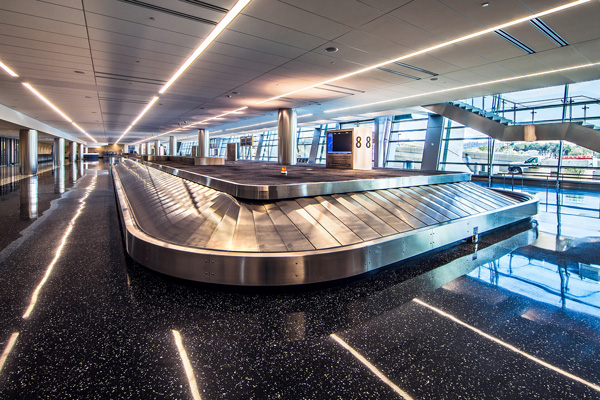The year is 2020, and you’re headed to catch a flight at San Diego International Airport. As you wake up over the course of the morning, your smartphone or wearable receives updated information on weather, traffic conditions, and flight times. An app instantly downloads all the information you’ll need to drop your bags, find your gate, and get seated in time for takeoff. As you approach the terminal, a drone leads you to the open parking spot most convenient for your specific flight. You walk toward the airport, and customized digital signs change to direct you to your exact destination. You glance at your wearable device to receive instructions guiding you through security, and as you approach a café, the barista has received your usual order and hands you a latte as you wave a device to pay for service.

This is the experience Rick Belliotti and his team are working to create at the Southern California travel hotspot—and they’re well on their way.
“I can really see many of these developments inside of five years,” says the airport’s director of information and technology services. What’s standing in the way? It’s not vision, resources, or even budget; Belliotti says airports like San Diego are always investing in hardware and tech infrastructure. In fact, travelers who come to the airport armed with several devices are the hardware providers. The real challenge lies in streamlining the experience. Now, every airline, airport, vendor, and travel company has its own app, and Belliotti knows no traveler will download and use a dozen apps as they crisscross a busy airport.
The experience has to be easier. “It has to be about the passenger and not about the company or destination,” Belliotti says. Traveling is—or can be—stressful and time-consuming. And that’s exactly what he wants to change about it.
As beacons, wearables, and other emerging technologies and platforms birth a renaissance in airports, Belliotti is looking to change the conversation. “We once had the mentality of a landlord and created relationships where we simply rented out space and managed leases,” he says. “We’re now interested in making the customer experience better, and we’re most interested in how we can impact their journey to make it more enjoyable and less stressful.”
No More Lost Luggage
One program designed to enhance the user experience and increase airport efficiency in San Diego is its new beacon program. Belliotti and his IT pros created an application that identifies a beacon on luggage so users know exactly when their property slides onto the carousel after a flight. Instead of pushing through anxious crowds, users can now greet waiting family members and relax until they receive an automated message indicating it’s time for them to pick up their luggage. The next step is to expand the program to track lost luggage or place beacons with travelers or carry-on bags so the airport can offer promotions or personalized order-delivery from nearby shops, kiosks, and concessions.
Leveraging new and existing technology is key in meeting those objectives. When iPhones and other smartphones became more ubiquitous in 2007, the air-travel industry started harnessing geospatial referencing to interact with passengers. Now, Belliotti is weaving in beacon technologies while looking forward to augmented and virtual reality.
In leading every IT project at San Diego, Belliotti classifies passengers into two general buckets: business and leisure. Business travelers value speed with low human interaction. Leisure travelers, often less experienced in navigating the airport, value customer service. “Our goal becomes to personalize the experience so the business traveler can speed through while the leisure traveler can feel reassured along the way,” he says. Technology is helping him cater to both groups through indoor geolocation with blue dotting from Apple and Google. International travelers can already use an automated kiosk to speed through customs and one day may be able to use a mobile app.
In operations, Belliotti’s vision is to see the airport get much smarter as his teams weave in sensors and devices that communicate back to maintenance professionals. Instead of simple preventative maintenance, they’re moving to a system in which sensors monitor statuses and allow crews to remotely monitor all areas to proactively repair certain functions.
Belliotti started his career as a software developer at Motorola and moved into the air-transportation field in 2001. He traveled the world as an IT consultant and corporate VP, which he says gave him great insight into what airports around the world are doing right and wrong to accommodate their passengers. Today, he’s drawing inspiration from France’s Charles De Gaulle airport, which he praises for visual layout; Schiphol in Amsterdam, which offers flawless intermodal transportation and convenient self bag drop; and Stockholm’s Arlanda Airport, which lets travelers check in without ever receiving a boarding pass or even presenting an ID—instead, people simply use their fingerprints as boarding tokens.
SAN DIEGO INTERNATIONAL AIRPORT stats
1928
Year the airport was dedicated
51
Gates in terminals
1 and 2
19M
Passengers go through the airport each year
It’s not just the industry that’s driving change in air travel. Belliotti and his peers at other airports are looking to other enterprises for best practices. He cites Disney’s MagicBand program as one example. “There’s no reason we can’t adopt this program and pre-ship RFID wristbands connected to a passenger’s information so they simply touch their band to a sensor to check in, pay for concessions, and go through security,” he says. Air New Zealand is already using a similar technology to monitor the activity and safe delivery of unaccompanied minors on its flights.
This year, the IT team at the San Diego International Airport is creating an innovation lab. The space—fittingly housed in the recently closed commuter terminal—is unique in the industry. It’s designed as a mini terminal, complete with ticket counter, gate, and baggage belt. Belliotti says it will attract companies and solution providers that offer new innovation in air travel. “The products, services, and solutions that it births will drive the industry forward, and we’re jumping to the front of the line to create the latest innovations for our airport and others,” he explains. With the lab, the airport is taking an obsolete building and using it to create a seedbed for technologies of the future. The lab should be up and running in late 2016 for an eighteen-month trial.
Additionally, the team is working to continue San Diego’s renowned art programs through technology. “We want people to remember their experience at San Diego International, and we want them to talk about us in a positive way on social media,” Belliotti says. He’s working to supplement art exhibits with videos that tell the backstories of each piece or share the biographies of each artist. The exhibits will use geolocation services to interact with visitors and provide supplemental digital content. A six-foot wide, 700-foot long art installation in Terminal 2 known as “The Journey” features computer-generated images displayed on 38,000 suspended LED lights. Travelers have posted their own videos of the display on YouTube thousands of times.
For Belliotti, those videos are validation of his philosophy. He’s doing all he can to leverage technology to improve and enhance customer experience at San Diego International, and his team continues to look for new ways to make things faster, better, and easier for the passenger.


